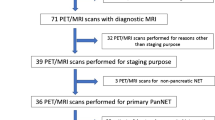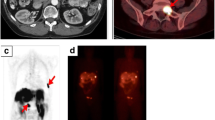Abstract
Objectives
To quantify the additional value of 68Ga-DOTA-TATE PET/CT in comparison with contrast-enhanced CT alone for primary tumour detection in neuroendocrine cancer of unknown primary (CUP-NET).
Methods
In total, 38 consecutive patients (27 men, 11 women; mean age 62 years) with histologically proven CUP-NET who underwent a contrast-enhanced 68Ga-DOTA-TATE PET/CT scan for primary tumour detection and staging between 2010 and 2014 were included in this IRB-approved retrospective study. Two blinded readers independently analysed the contrast-enhanced CT and 68Ga-DOTA-TATE PET datasets separately and noted from which modality they suspected a primary tumour. Consensus was reached if the results were divergent. Postoperative histopathology (24 patients) and follow-up 68Ga-DOTA-TATE PET/CT imaging (14 patients) served as the reference standards and statistical measures of diagnostic accuracy were calculated accordingly.
Results
The majority of confirmed primary tumours were located in the abdomen (ileum in 19 patients, pancreas in 12, lung in 2, small pelvis in 1). High interobserver agreement was noted regarding the suspected primary tumour site (Cohen’s k 0.90, p < 0.001). 68Ga-DOTA-TATE PET demonstrated a significantly higher sensitivity (94 % vs. 63 %, p = 0.005) and a significantly higher accuracy (87 % vs. 68 %, p = 0.003) than contrast-enhanced CT.
Conclusions
Ga-DOTA-TATE PET/CT compared with contrast-enhanced CT alone provides an improvement in sensitivity of 50 % and an improvement in accuracy of 30 % in primary tumour detection in CUP-NET.
Key Points
• 68Ga-DOTA-TATE PET augments the sensitivity of contrast-enhanced CT by 50 %
• 68Ga-DOTA-TATE PET augments the accuracy of contrast-enhanced CT by 30 %
• Somatostatin receptor-targeted hybrid imaging optimizes primary tumour detection in CUP-NET




Similar content being viewed by others
References
Pavlidis N, Pentheroudakis G (2012) Cancer of unknown primary site. Lancet 379:1428–1435
Oien KA (2009) Pathologic evaluation of unknown primary cancer. Semin Oncol 36:8–37
Massard C, Loriot Y, Fizazi K (2011) Carcinomas of an unknown primary origin – diagnosis and treatment. Nat Rev Clin Oncol 8:701–710
Hemminki K, Bevier M, Hemminki A, Sundquist J (2012) Survival in cancer of unknown primary site: population-based analysis by site and histology. Ann Oncol 23:1854–1863
Kazmierczak PM, Nikolaou K, Rominger A, Graser A, Reiser MF, Cyran CC (2014) Radiological diagnostics in CUP syndrome. Radiologe 54:117–123
Moller AK, Loft A, Berthelsen AK et al (2012) A prospective comparison of 18F-FDG PET/CT and CT as diagnostic tools to identify the primary tumor site in patients with extracervical carcinoma of unknown primary site. Oncologist 17:1146–1154
Karsell PR, Sheedy PF 2nd, O'Connell MJ (1982) Computed tomography in search of cancer of unknown origin. JAMA 248:340–343
Lee JR, Kim JS, Roh JL et al (2015) Detection of occult primary tumors in patients with cervical metastases of unknown primary tumors: comparison of (18)F FDG PET/CT with contrast-enhanced CT or CT/MR imaging – prospective study. Radiology 274:764–771
Elboga U, Kervancioglu S, Sahin E, Basibuyuk M, Celen YZ, Aktolun C (2014) Utility of F-18 fluorodeoxyglucose positron emission tomography/computed in carcinoma of unknown primary. Int J Clin Exp Pathol 7:8941–8946
Han A, Xue J, Hu M, Zheng J, Wang X (2012) Clinical value of 18F-FDG PET-CT in detecting primary tumor for patients with carcinoma of unknown primary. Cancer Epidemiol 36:470–475
Pape UF, Perren A, Niederle B et al (2012) ENETS Consensus guidelines for the management of patients with neuroendocrine neoplasms from the jejuno-ileum and the appendix including goblet cell carcinomas. Neuroendocrinology 95:135–156
Kayani I, Bomanji JB, Groves A et al (2008) Functional imaging of neuroendocrine tumors with combined PET/CT using 68Ga-DOTATATE (DOTA-DPhe1, Tyr3-octreotate) and 18F-FDG. Cancer 112:2447–2455
Bergsland EK, Nakakura EK (2014) Neuroendocrine tumors of unknown primary: is the primary site really not known? JAMA Surg 149:889–890
Kjaer A, Knigge U (2015) Use of radioactive substances in diagnosis and treatment of neuroendocrine tumors. Scand J Gastroenterol 50:740–747
Rossana B, Silvia R, Mariangela T et al (2016) Gastrointestinal neuroendocrine tumors: searching the optimal treatment strategy – a literature review. Crit Rev Oncol Hematol 98:264–274
Alonso O, Rodriguez-Taroco M, Savio E, Bentancourt C, Gambini JP, Engler H (2014) (68)Ga-DOTATATE PET/CT in the evaluation of patients with neuroendocrine metastatic carcinoma of unknown origin. Ann Nucl Med 28:638–645
Hofman MS, Lau WF, Hicks RJ (2015) Somatostatin receptor imaging with 68Ga DOTATATE PET/CT: clinical utility, normal patterns, pearls, and pitfalls in interpretation. Radiographics 35:500–516
Breeman WA, de Jong M, de Blois E, Bernard BF, Konijnenberg M, Krenning EP (2005) Radiolabelling DOTA-peptides with 68Ga. Eur J Nucl Med Mol Imaging 32:478–485
Naswa N, Sharma P, Kumar A et al (2012) (68)Ga-DOTANOC PET/CT in patients with carcinoma of unknown primary of neuroendocrine origin. Clin Nucl Med 37:245–251
Prasad V, Ambrosini V, Hommann M, Hoersch D, Fanti S, Baum RP (2010) Detection of unknown primary neuroendocrine tumours (CUP-NET) using (68)Ga-DOTA-NOC receptor PET/CT. Eur J Nucl Med Mol Imaging 37:67–77
Ambrosini V, Nanni C, Zompatori M et al (2010) (68)Ga-DOTA-NOC PET/CT in comparison with CT for the detection of bone metastasis in patients with neuroendocrine tumours. Eur J Nucl Med Mol Imaging 37:722–727
Auernhammer CJ, Goke B (2011) Therapeutic strategies for advanced neuroendocrine carcinomas of jejunum/ileum and pancreatic origin. Gut 60:1009–1021
Ahmed A, Turner G, King B et al (2009) Midgut neuroendocrine tumours with liver metastases: results of the UKINETS study. Endocr Relat Cancer 16:885–894
Hellman P, Lundstrom T, Ohrvall U et al (2002) Effect of surgery on the outcome of midgut carcinoid disease with lymph node and liver metastases. World J Surg 26:991–997
Capurso G, Bettini R, Rinzivillo M, Boninsegna L, Delle Fave G, Falconi M (2011) Role of resection of the primary pancreatic neuroendocrine tumour only in patients with unresectable metastatic liver disease: a systematic review. Neuroendocrinology 93:223–229
Caplin ME, Baudin E, Ferolla P et al (2015) Pulmonary neuroendocrine (carcinoid) tumors: European Neuroendocrine Tumor Society expert consensus and recommendations for best practice for typical and atypical pulmonary carcinoids. Ann Oncol 26:1604–1620
Johnbeck CB, Knigge U, Kjaer A (2014) PET tracers for somatostatin receptor imaging of neuroendocrine tumors: current status and review of the literature. Future Oncol 10:2259–2277
Kabasakal L, Demirci E, Ocak M et al (2012) Comparison of (68)Ga-DOTATATE and (68)Ga-DOTANOC PET/CT imaging in the same patient group with neuroendocrine tumours. Eur J Nucl Med Mol Imaging 39:1271–1277
Kwee TC, van Ufford HM, Beek FJ et al (2009) Whole-body MRI, including diffusion-weighted imaging, for the initial staging of malignant lymphoma: comparison to computed tomography. Invest Radiol 44:683–690
Look Hong NJ, Petrella T, Chan K (2015) Cost-effectiveness analysis of staging strategies in patients with regionally metastatic melanoma. J Surg Oncol 111:423–430
Baur AD, Pavel M, Prasad V, Denecke T (2016) Diagnostic imaging of pancreatic neuroendocrine neoplasms (pNEN): tumor detection, staging, prognosis, and response to treatment. Acta Radiol 57:260–270
Ruf J, Schiefer J, Furth C et al (2011) 68Ga-DOTATOC PET/CT of neuroendocrine tumors: spotlight on the CT phases of a triple-phase protocol. J Nucl Med 52:697–704
Manfredi R, Bonatti M, Mantovani W et al (2013) Non-hyperfunctioning neuroendocrine tumours of the pancreas: MR imaging appearance and correlation with their biological behaviour. Eur Radiol 23:3029–3039
Acknowledgments
The scientific guarantor of this publication is PD Dr. med. Clemens C. Cyran. The authors of this manuscript declare relationships with the following companies:
Clemens C. Cyran: speaker’s bureau Siemens Healthcare, research grants Bayer HealthCare and Novartis.
Christine Spitzweg: honoraria for advisory board and lectures from Novartis, Pfizer and Ipsen.
Christoph Auernhammer: research grants and lecture honoraria from Novartis and Ipsen, advisory board honoraria from Novartis.
The authors state that this work has not received any funding. No complex statistical methods were necessary for this study. Institutional Review Board approval was obtained. Written informed consent was waived by the Institutional Review Board. Methodology: retrospective, diagnostic or prognostic study, performed at one institution.
Author information
Authors and Affiliations
Corresponding author
Rights and permissions
About this article
Cite this article
Kazmierczak, P.M., Rominger, A., Wenter, V. et al. The added value of 68Ga-DOTA-TATE-PET to contrast-enhanced CT for primary site detection in CUP of neuroendocrine origin. Eur Radiol 27, 1676–1684 (2017). https://doi.org/10.1007/s00330-016-4475-3
Received:
Revised:
Accepted:
Published:
Issue Date:
DOI: https://doi.org/10.1007/s00330-016-4475-3




